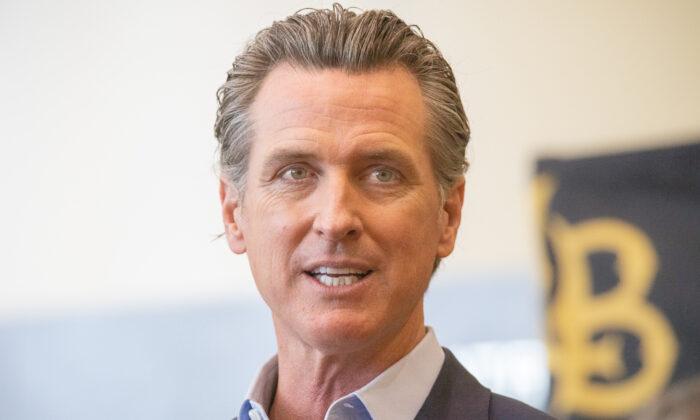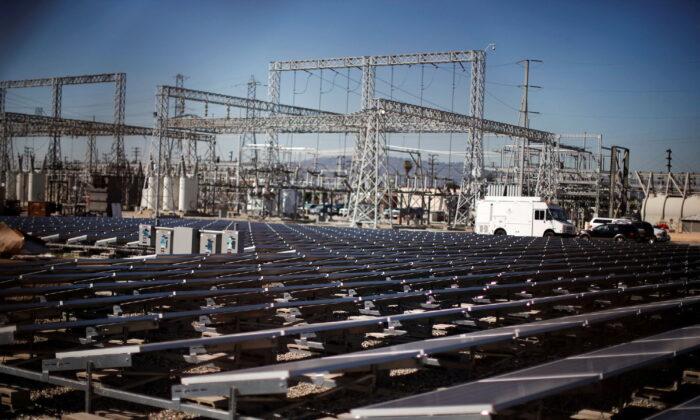As California Gov. Gavin Newsom fights to keep his seat ahead of an impending gubernatorial recall vote, his efforts could be hindered by forces beyond his control.
The main menaces to Newsom’s continuation in the governor’s office—wildfires and blackouts—are by force of circumstance.
In California, public employee unions are by far the most powerful political force.
The second threat comes from expected massive electricity blackouts as the summer heat begins to take hold.
The fact is that neither Newsom, nor his recent predecessors—Gray Davis, Arnold Schwarzenegger, or Jerry Brown—prepared the state for its current electricity needs.
The state effectively has two parallel power grids. One carries traditional energy from coal, gas, and nuclear power plants, several of which are in other states; the second carries electrons from the wind, solar, and geothermal “renewables.”
Recall Precedent
I wrote almost all the editorials for the Orange County Register leading up to the Oct. 7, 2003, recall of then-governor Davis. It’s interesting to contrast that event, in which Schwarzenegger was elected as the replacement governor, to the current attempt to recall Newsom.Things are quite different today, with Orange County moving significantly in the direction of its more liberal northern neighbor.
In 2003, all Orange County’s members of Congress were Republicans, compared to just two today. A year ago, all seven were Democrats. Last November, two incumbent Democrats—representatives Harley Rouda and Gil Cisneros—were narrowly defeated. They were replaced, respectively, by new Republican congresswomen Young Kim and Michelle Steel.
A New Media Ballgame
In 2003, the internet was just getting started among regular Americans. The iPhone was four years away. Social media didn’t exist. Television media was much more influential, while newspapers dominated news and opinion.One Faulconer ad attacks the school closures, but they’ll be open in August for the new school year. And he blasts the state’s business and tax climate, even as Newsom is promising to spread around a budget surplus of $76 billion, at least according to his creative accounting.
In his ads, former representative Doug Ose is stressing that because of Newsom, the state is “chaotic” and “screwed up.” He said, “I’m just not going to stand aside and let it get worse.”
No Arnold
In 2003, Schwarzenegger depended on his star power to both give people a reason to dump Davis and to put the actor in the governor’s chair.It was impossible for Davis to terminate the Terminator.
Today Newsom is pushing his own new ads.
It quotes Jeff Bezos’ Washington Post, which charged that “Republicans are undermining democracy.”
How can a recall, the very definition of direct, participatory democracy, be “undermining democracy”?
Didn’t Hiram Johnson and other progressive reformers in 1911 institute recalls precisely to restore democracy after it had been corrupted by the oligarchs of the day? Never mind.
Latest Polls Back Newsom
The May 25 Public Policy Institute of California poll pegged recall support among registered voters at 40 percent, with 53 percent opposed and three percent unsure. Republicans back it with 78 percent, to 47 percent for independents, and just 11 percent for Democrats.With the election expected to be called for November, it’s still more than four months before the voters get their say.
Anything could happen.
But unless the situation in the state dramatically turns for the worse, it’s going to be tough to dislodge Newsom.
Then next year, the process begins again with the state primary set for June 7 and the general for Nov. 8.
The Davis recall came less than a year after his reelection in 2002, meaning his replacement enjoyed more than three years in office. Newsom recall proponents might have been better to wait until 2023, by which time the state economy might also be going sour.
But it’s too late to make that course correction.





